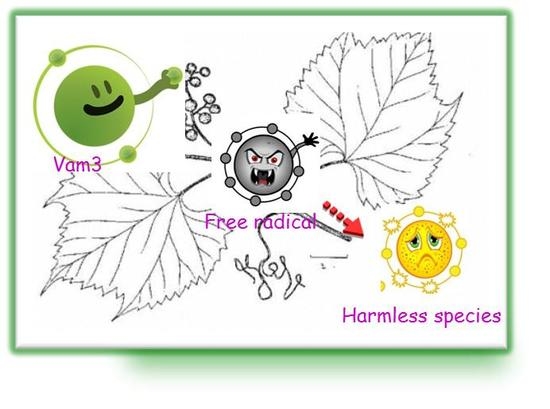Antioxidant Properties of the Vam3 Derivative of Resveratrol
Abstract
1. Introduction
2. Computational Details
3. Discussion
4. Conclusions
- Atom transfer seems to be the most probable mechanism followed by Vam3 in its action of radical scavenger especially in an apolar solvent due to the fact that the first step of both the SPLET and SET-PT pathways appears to be strongly endergonic. The height of activation barriers computed for the hydrogen atom transfer to the ·OOH free radical are quite low, and reinforce this hypothesis. In water, all three working mechanisms are probable because, although the first two steps of SET-PT and SPLET are in any case endergonic processes, the energies at stake are less prohibitive than those required in a lipid-like environment.
- Radical adduct formation, in rare cases favored thermodynamically, presents very high activation barriers that allow to permanently exclude this mechanism among those that Vam3 could adopt to counteract the action of free radicals.
- Based on the BDE value, Vam3 seems to be a good candidate useful for minimizing or preventing lipid oxidation, retarding the formation of toxic oxidation products even more effective than resveratrol and many other phenolic compounds.
Supplementary Materials
Author Contributions
Funding
Acknowledgments
Conflicts of Interest
References
- Pham-Huy, L.A.; He, H.; Pham-Huy, C. Free radicals, antioxidants in disease and health. Int. J. Biomed. Sci. 2008, 4, 89–96. [Google Scholar] [PubMed]
- Lobo, V.; Patil, A.; Phatak, A.; Chandra, N. Free radicals, antioxidants and functional foods: Impact on human health. Pharm. Rev. 2010, 4, 118–126. [Google Scholar] [CrossRef] [PubMed]
- Alkadi, H. A review on free radicals and antioxidants. Infect. Disord.-Drug Targets 2018. [Google Scholar] [CrossRef] [PubMed]
- Valko, M.; Leibfritz, D.; Moncol, J.; ronin, M.T.; Mazur, M.; Telser, J. Free radicals and antioxidants in normal physiological functions and human disease. Int. J. Biochem. Cell Biol. 2007, 39, 44–84. [Google Scholar] [CrossRef] [PubMed]
- Lin, D.; Xiao, M.; Zhao, J.; Li, Z.; Xing, B.; Li, X.; Kong, M.; Li, L.; Zhang, Q.; Liu, Y.; et al. An overview of plant phenolic compounds and their importance in human nutrition and management of type 2 diabetes. Molecules 2016, 21, 1374. [Google Scholar] [CrossRef] [PubMed]
- Burns, J.; Yokota, T.; Ashihara, H.; Lean, M.E.J.; Crozier, A. Plant Foods and Herbal Sources of Resveratrol. J. Agric. Food Chem. 2002, 50, 3337–3340. [Google Scholar] [CrossRef] [PubMed]
- De Lorgeril, M.; Salen, P.; Paillard, F.; Laporte, F.; Boucher, F.; de Leiris, J. Mediterranean diet and the French paradox: Two distinct biogeographic concepts for one consolidated scientific theory on the role of nutrition in coronary heart disease. Cardiovasc. Res. 2002, 54, 503–515. [Google Scholar] [CrossRef]
- Bradamante, S.; Barenghi, L.; Villa, A. Cardiovascular Protective Effects of Resveratrol. Cardiovasc. Drug Rev. 2004, 22, 169–188. [Google Scholar] [CrossRef] [PubMed]
- Parodi, P.W. The French paradox unmasked: The role of folate. Med. Hypotheses 1977, 9, 313–318. [Google Scholar] [CrossRef]
- Kolouchova, I.; Melzoch, K.; Smidrkal, J.; Filip, V. The content of resveratrol in vegetables and fruit. Chem. Listy 2005, 99, 492–495. [Google Scholar]
- Gusman, J.; Malonne, H.; Atassi, G. A reappraisal of the potential chemopreventive and chemotherapeutic properties of resveratrol. Carcinogenesis 2001, 22, 1111–1117. [Google Scholar] [CrossRef] [PubMed]
- De la Lastra, C.A.; Villegas, I. Resveratrol as an anti-inflammatory and anti-aging agent: Mechanisms and clinical implications. Mol. Nutr. Food Res. 2005, 49, 405–430. [Google Scholar] [CrossRef] [PubMed]
- Vastano, B.C.; Chen, Y.; Zhu, N.; Ho, C.T.; Zhou, Z.; Rosen, R.T. Isolation and identification of stilbenes in two varieties of Polygonum cuspidatum. J. Agric. Food Chem. 2000, 48, 253–256. [Google Scholar] [CrossRef] [PubMed]
- Shi, J.; Yin, N.; Xuan, L.L.; Yao, C.S.; Meng, A.M.; Hou, Q. Vam3, a derivative of resveratrol, attenuates cigarette smoke-induced autophagy. Acta Pharmacol. Sin. 2012, 33, 888–896. [Google Scholar] [CrossRef] [PubMed]
- Jiang, M.; Liu, R.; Chen, Y.; Zheng, Q.; Fan, S.; Liu, P. A Combined Experimental and Computational Study of Vam3, a Derivative of Resveratrol, and Syk Interaction. Int. J. Mol. Sci. 2014, 15, 17188–17203. [Google Scholar] [CrossRef] [PubMed]
- Mazzone, G.; Malaj, N.; Russo, N.; Toscano, M. Density functional study of the antioxidant activity of some recently synthesized resveratrol analogues. Food Chem. 2013, 141, 2017–2024. [Google Scholar] [CrossRef] [PubMed]
- Leopoldini, M.; Marino, T.; Russo, N.; Toscano, M. Antioxidant properties of phenolic compounds: H-atom versus electron transfer mechanism. J. Phys. Chem. A 2004, 108, 4916–4922. [Google Scholar] [CrossRef]
- Leopoldini, M.; Russo, N.; Toscano, M. The molecular basis of working mechanism of natural polyphenolic antioxidants. Food Chem. 2011, 125, 288–306. [Google Scholar] [CrossRef]
- Leopoldini, M.; Chiodo, S.G.; Russo, N.; Toscano, M. Detailed investigation of the OH radical quenching by natural antioxidant caffeic acid studied by quantum mechanical models. J. Chem. Theory Comput. 2011, 7, 4218–4233. [Google Scholar] [CrossRef] [PubMed]
- Iuga, C.; Alvarez-Idaboy, J.R.; Russo, N. Antioxidant activity of trans resveratrol toward hydroxyl and hydroperoxyl radicals: A quantum chemical and computational kinetics study. J. Org. Chem. 2012, 77, 3868–3877. [Google Scholar] [CrossRef] [PubMed]
- Galano, A.; Mazzone, G.; Alvarez-Diduk, R.; Marino, T.; Alvarez-Idaboy, J.R.; Russo, N. Food Antioxidants: Chemical Insights at the Molecular Level. Ann. Rev. Food Sci. Tech. 2016, 7, 335–352. [Google Scholar] [CrossRef] [PubMed]
- Galano, A.; Alvarez-Idaboy, J.R. Guanosine + OH radical reaction in aqueous solution: A reinterpretation of the UV-vis data based on thermodynamic and kinetic calculations. Org. Lett. 2009, 11, 5114–5117. [Google Scholar] [CrossRef] [PubMed]
- Litwinienko, G.; Ingold, K.U. Abnormal solvent effects on hydrogen atom abstractions. The reactions of phenols with 2,2-diphenyl-1-picrylhydrazyl (dpph·) in alcohols. J. Org. Chem. 2003, 68, 3433–3438. [Google Scholar] [CrossRef] [PubMed]
- Becke, A.D. Density-Functional Thermochemistry. III. The Role of Exact Exchange. J. Chem. Phys. 1993, 98, 5648–5652. [Google Scholar] [CrossRef]
- Lee, C.; Yang, W.; Parr, R.G. Development of the Colle-Salvetti Correlation-Energy Formula into a Functional of the Electron Density. Phys. Rev. B Condens. Matter Mater. Phys. 1988, 37, 785–789. [Google Scholar] [CrossRef]
- Frisch, M.J.; Trucks, G.W.; Schlegel, H.B.; Scuseria, G.E.; Robb, M.A.; Cheeseman, J.R.; Scalmani, G.; Barone, V.; Mennucci, B.; Petersson, G.A.; et al. Gaussian 09; Revision, D.01; Gaussian, Inc.: Wallingford, CT, USA, 2009. [Google Scholar]
- Sousa, S.F.; Fernandes, P.A.; Ramos, M.J. General Performance of Density Functionals. J. Phys. Chem. A 2007, 111, 10439–10452. [Google Scholar] [CrossRef] [PubMed]
- Weinhold, F.; Carpenter, J. The Structure of Small Molecules and Ions; Naaman, R., Vager, Z., Eds.; Plenum: New York, NY, USA, 1988; pp. 227–236. [Google Scholar]
- Vincenzo, B.; Cossi, M.; Tomasi, J. A new definition of cavities for the computation of solvation free energies by the polarizable continuum model. J. Chem. Phys. 1997, 107, 3210–3221. [Google Scholar] [CrossRef]
- Li, L.; Li, C.; Zhang, Z.; Alexov, E. On the Dielectric “Constant” of Proteins: Smooth Dielectric Function for Macromolecular Modeling and Its Implementation in DelPhi. Chem. Theory Comput. 2013, 9, 2126–2136. [Google Scholar] [CrossRef] [PubMed]
- Markovic, Z.; Tošovic, J.; Milenkovic, D.; Markovic, S. Revisiting the solvation enthalpies and free energies of the proton and electron in various solvents. Comput. Theor. Chem. 2016, 1077, 11–17. [Google Scholar] [CrossRef]
- Nazarparvar, E.; Zahedi, M.; Klein, E. Density Functional Theory (B3LYP) Study of Substituent Effects on O−H Bond Dissociation Enthalpies of trans-Resveratrol Derivatives and the Role of Intramolecular Hydrogen Bonds. J. Org. Chem. 2012, 77, 10093–10104. [Google Scholar] [CrossRef] [PubMed]
- Lu, L.; Zhu, S.; Zhang, H.; Lia, F.; Zhanga, S. Theoretical study of complexation of resveratrol with cyclodextrins and cucurbiturils: Structure and antioxidative activity. RSC Adv. 2015, 5, 14114–14122. [Google Scholar] [CrossRef]
- Camont, L.; Collin, F.; Couturier, M.; Thérond, P.; Jore, D.; Gardès-Albert, M.; Bonnefont-Rousselot, D. Radical-induced oxidation of trans-resveratrol. Biochimie 2012, 94, 741–747. [Google Scholar] [CrossRef] [PubMed]
Sample Availability: Samples of the compounds are not available from the authors. |
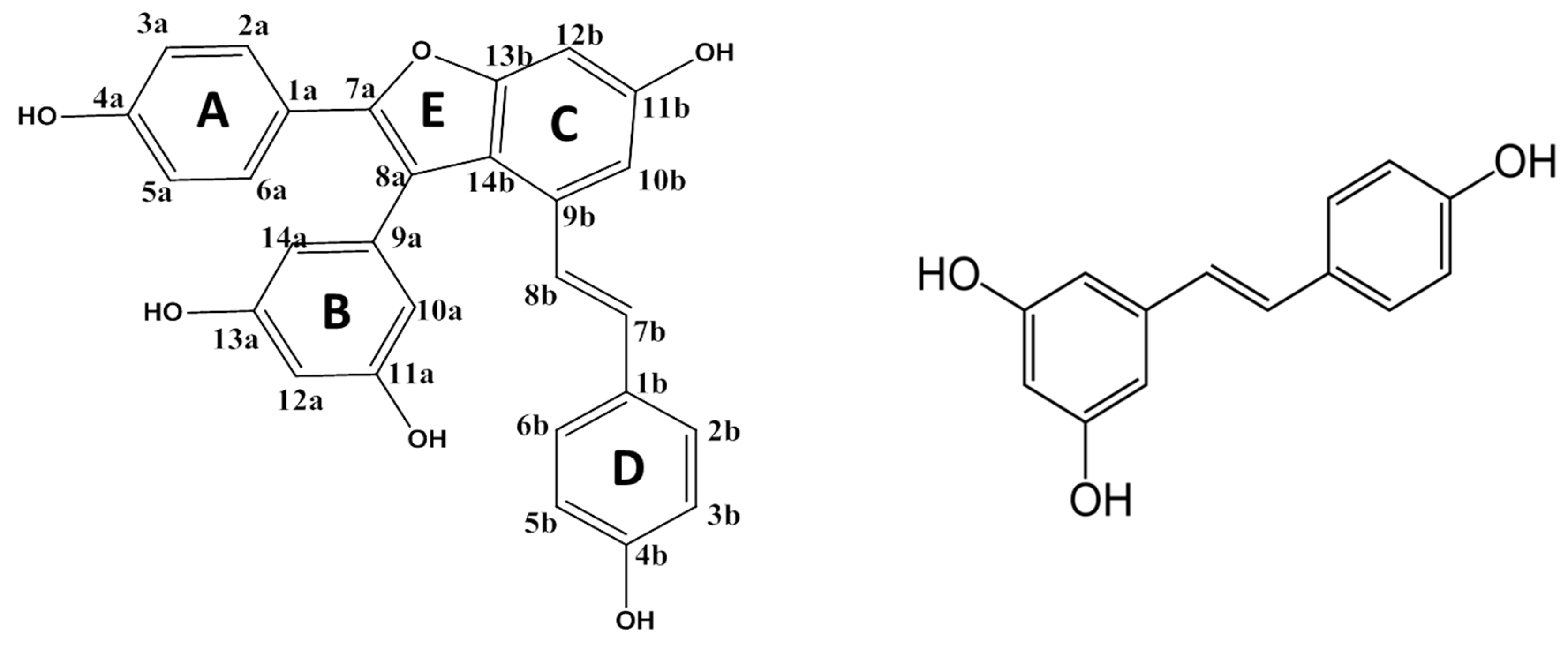
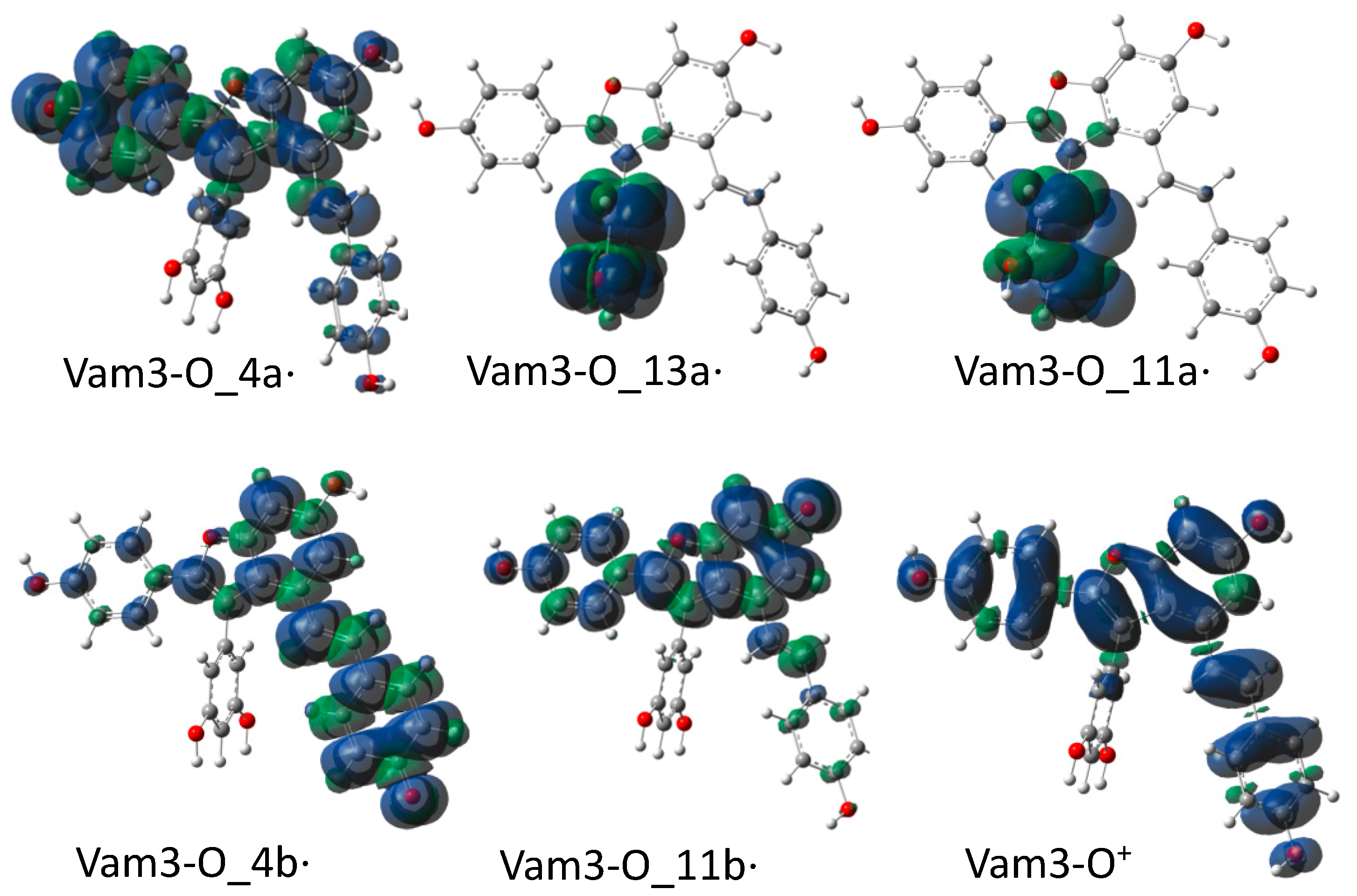
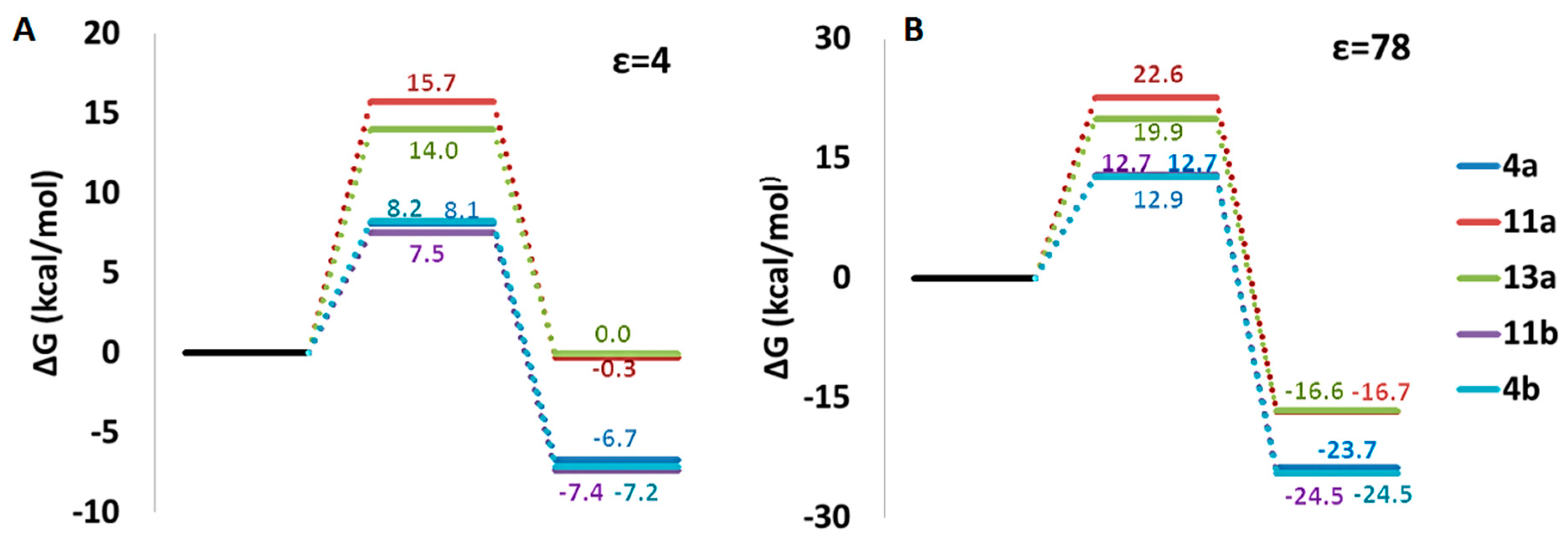

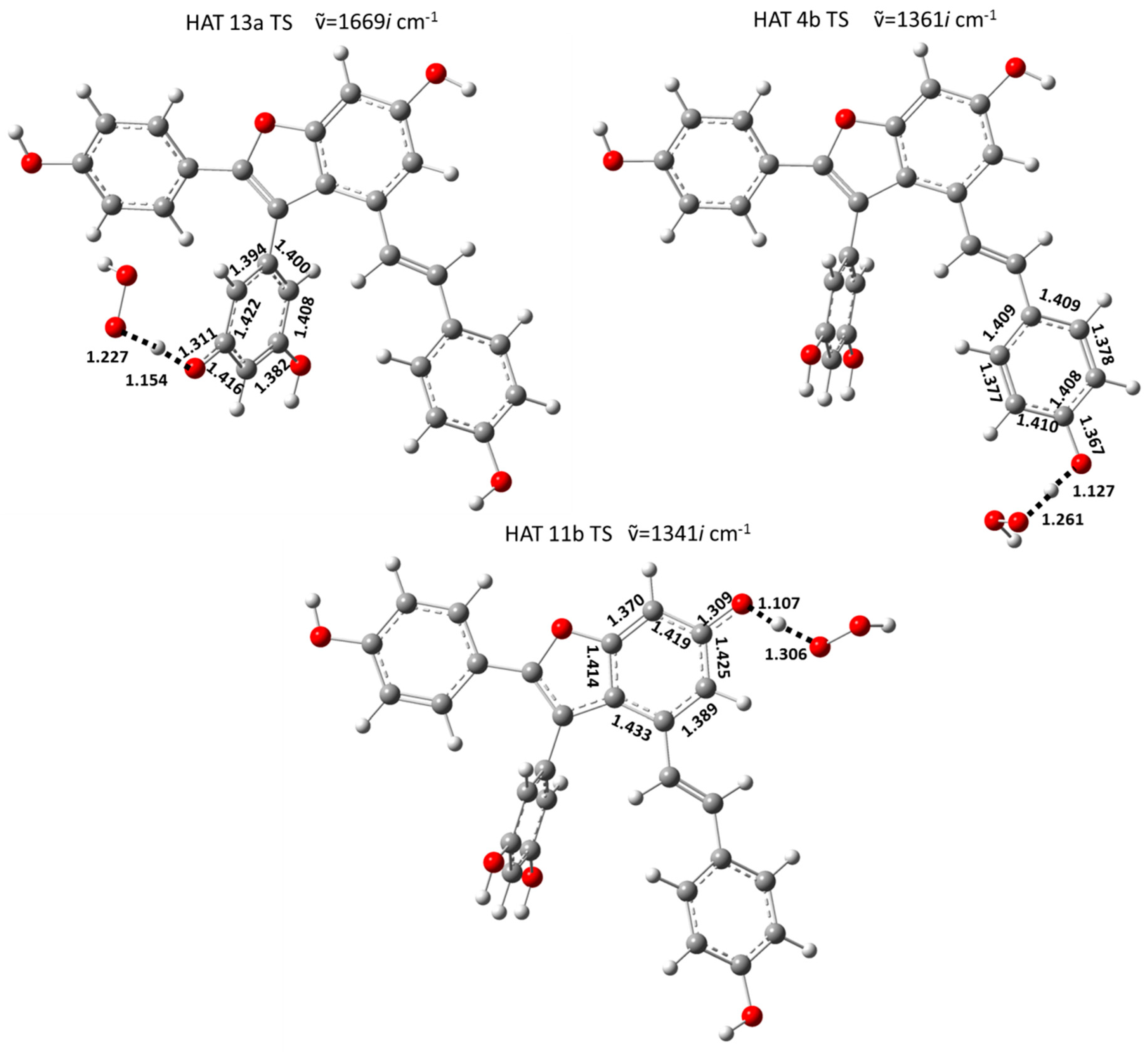
| Species | BDE | IP | PA | PDE | ETE | |||||
|---|---|---|---|---|---|---|---|---|---|---|
| ε = 4.0 | ε = 80.0 | ε = 4.0 | ε = 80.0 | ε = 4.0 | ε = 80.0 | ε = 4.0 | ε = 80.0 | ε = 4.0 | ε = 80.0 | |
| Vam3–O_4a· | 68.1 | 45.7 | 16.0 | 12.6 | 55.7 | 65.9 | ||||
| Vam3–O_11a· | 74.4 | 52.7 | 22.3 | 19.6 | 69.7 | 78.2 | ||||
| Vam3–O_13a· | 74.7 | 52.9 | 22.6 | 19.8 | 68.3 | 76.7 | ||||
| Vam3–O_11b· | 67.3 | 45.2 | 15.2 | 12.1 | 63.1 | 72.1 | ||||
| Vam3–O_4b· | 67.6 | 45.0 | 15.5 | 11.9 | 61.3 | 72.3 | ||||
| Anion_4a | 60.1 | 18.4 | ||||||||
| Anion_11a | 52.4 | 13.0 | ||||||||
| Anion_13a | 54.1 | 14.7 | ||||||||
| Anion_11b | 51.9 | 11.6 | ||||||||
| Anion_4b | 54.0 | 11.2 | ||||||||
| Vam3+ | 117.6 | 71.6 | ||||||||
| ΔG (kcal/mol) | ||||||||||
|---|---|---|---|---|---|---|---|---|---|---|
| 4a | 11a | 13a | 11b | 4b | ||||||
| ε = 4.0 | ε = 80.0 | ε = 4.0 | ε = 80.0 | ε = 4.0 | ε = 80.0 | ε = 4.0 | ε = 80.0 | ε = 4.0 | ε = 80.0 | |
| HAT | −6.7 | −23.8 | −0.3 | −16.8 | −0.0 | −16.6 | −7.4 | −24.3 | −7.2 | −24.5 |
| SPLET | ||||||||||
| 1° Step | 60.1 | 18.4 | 52.4 | 13.0 | 54.2 | 14.7 | 52.9 | 11.6 | 54.0 | 11.2 |
| 2° Step | −66.8 | −42.2 | −52.7 | −29.7 | −54.2 | −31.3 | −59.3 | −35.9 | −61.1 | −35.7 |
| ΔΔG (kcal/mol) | −6.7 | −23.8 | −0.3 | −16.7 | −0.0 | −16.6 | −7.4 | −24.3 | −7.2 | −24.5 |
| SET-PT | ||||||||||
| 1° Step | 44.4 | 4.6 | 44.4 | 4.6 | 44.4 | 4.6 | 44.4 | 4.6 | 44.4 | 4.6 |
| 2° Step | −51.1 | −28.4 | −44.7 | −21.4 | −44.5 | −21.2 | −51.8 | −28.9 | −51.6 | −29.1 |
| ΔΔG (kcal/mol) | −6.7 | −23.8 | −0.3 | −16.8 | −0.0 | −16.6 | −7.4 | −24.3 | −7.2 | −24.5 |
| ΔG (kcal/mol) | ΔG (kcal/mol) | ||||
|---|---|---|---|---|---|
| Species | ε = 4.0 | ε = 80.0 | Species | ε = 4.0 | ε = 80.0 |
| RAF_1a | 31.9 | 37.5 | RAF_8b | 10.1 | −11.3 |
| RAF_2a | 20.8 | 26.4 | RAF_7b | 6.4 | −14.7 |
| RAF_3a | 23.8 | 50.1 | RAF_1b | 30.8 | 10.4 |
| RAF_4a | 18.2 | 24.1 | RAF_2b | 20.6 | −1.4 |
| RAF_5a | 24.6 | 30.4 | RAF_3b | 24.4 | 1.8 |
| RAF_6a | 22.2 | 3.1 | RAF_4b | 16.2 | −4.3 |
| RAF_7a | 14.5 | −5.8 | RAF_5b | 24.9 | 10.4 |
| RAF_8a | 17.8 | 44.5 | RAF_6b | 20.7 | 1.5 |
| RAF_14b | 33.8 | 61.1 | RAF_9a | 36.6 | 14.8 |
| RAF_13b | 25.3 | 2.9 | RAF_10a | 23.1 | 2.2 |
| RAF_12b | 15.1 | −7.7 | RAF_11a | −5.2 | 55.4 |
| RAF_11b | 19.9 | −1.8 | RAF_12a | 21.6 | 4.4 |
| RAF_10b | 18.0 | −0.3 | RAF_13a | 24.9 | 4.5 |
| RAF_9b | 23.5 | 2.5 | RAF_14a | 23.4 | 1.6 |
| ΔG‡ (kcal/mol) | ||
|---|---|---|
| Species | ε = 4.0 | ε = 80.0 |
| RAF_7a | 26.3 | |
| RAF_12b | 26.7 | |
| RAF_11b | 30.3 | |
| RAF_10b | 29.0 | |
| RAF_8b | 24.4 | |
| RAF_7b | 25.1 | |
| RAF_2b | 31.4 | |
| RAF_4b | 29.3 | |
| RAF_11a | 29.1 | |
© 2018 by the authors. Licensee MDPI, Basel, Switzerland. This article is an open access article distributed under the terms and conditions of the Creative Commons Attribution (CC BY) license (http://creativecommons.org/licenses/by/4.0/).
Share and Cite
Ahmadi, S.; Marino, T.; Prejanò, M.; Russo, N.; Toscano, M. Antioxidant Properties of the Vam3 Derivative of Resveratrol. Molecules 2018, 23, 2446. https://doi.org/10.3390/molecules23102446
Ahmadi S, Marino T, Prejanò M, Russo N, Toscano M. Antioxidant Properties of the Vam3 Derivative of Resveratrol. Molecules. 2018; 23(10):2446. https://doi.org/10.3390/molecules23102446
Chicago/Turabian StyleAhmadi, Seyedmohammad, Tiziana Marino, Mario Prejanò, Nino Russo, and Marirosa Toscano. 2018. "Antioxidant Properties of the Vam3 Derivative of Resveratrol" Molecules 23, no. 10: 2446. https://doi.org/10.3390/molecules23102446
APA StyleAhmadi, S., Marino, T., Prejanò, M., Russo, N., & Toscano, M. (2018). Antioxidant Properties of the Vam3 Derivative of Resveratrol. Molecules, 23(10), 2446. https://doi.org/10.3390/molecules23102446








